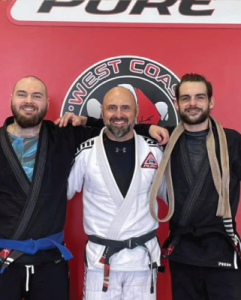How to be a good Purple Belt
Being a good purple belt in Brazilian Jiu Jitsu (BJJ) involves refining your techniques, developing advanced skills, understanding broader strategies, and contributing positively to your academy’s community. Here’s a comprehensive guide to excelling at the purple belt level:
1. Deepen Technical Proficiency
Advanced Techniques
Escapes and Defenses
- Advanced Mount Escapes: Technical mount escapes, kipping escapes.
- Side Control Escapes: Reguard, inverted guard recovery, underhook to single-leg.
- Submission Defenses: Advanced defenses against arm locks, leg locks, and various chokes.
Submissions
- Advanced Chokes: Bow and arrow choke, loop choke, Darce choke.
- Joint Locks: Omoplata variations, wrist locks, more complex arm and leg submissions.
- Combination Attacks: Linking submissions together, such as transitioning from triangle to armbar.
Sweeps
- Guard Sweeps: X-guard sweeps, De La Riva sweeps, reverse De La Riva sweeps.
- Half Guard Sweeps: Deep half guard sweeps, waiter sweep.
Guard Play
- Open Guard: Developing complex guard systems like spider guard, lasso guard, and inverted guard.
- Transitions: Fluidly moving between different guard positions and using them strategically.
Positional Control
- Top Game: Advanced pressure passing, knee slice variations, smash passing.
- Back Control: Refining back attacks, grip fighting, maintaining hooks.
Transitional Movements
- Dynamic Guard Passing: Leg drags, leg weaves, and advanced passing sequences.
- Advanced Takedowns: Incorporating judo throws, wrestling takedowns, and counters.

2. Master Broader Concepts and Principles
Strategic Thinking
Positional Hierarchy
- Positional Flow: Understanding and executing the flow between positions for control and attacks.
- Transitioning: Mastering the ability to move seamlessly from one position to another based on opponent reactions.
Attacking Principles
- Breaking Alignment: Using off-balancing and leverage to set up submissions and sweeps.
- Attack Chains: Developing and implementing sequences of attacks to overwhelm opponents.
Pressure and Control
Top Pressure
- Smash Passing: Using body weight effectively to control and pass guard.
- Pressure Control: Applying consistent pressure from top positions to tire and dominate opponents.
Timing and Rhythm
- Tempo Control: Dictating the pace of the match or roll to suit your strategy.
- Exploit Openings: Recognizing and exploiting brief windows of opportunity for attacks or escapes.
3. Refine and Expand Your Game
Game Plan Development
Personal Style
- Identify Strengths: Focus on refining techniques and strategies that align with your strengths.
- Address Weaknesses: Continuously work on areas of weakness and integrate them into your game.
Adaptability
- Adjust to Opponents: Develop the ability to adapt your strategy based on different opponents and scenarios.
- Versatility: Be comfortable with both offensive and defensive positions, including both top and bottom games.
Drilling and Sparring
Positional Drilling
- Situational Drills: Practice specific scenarios to improve reactions and solutions for common problems.
- Isolation Sparring: Focus on sparring from specific positions or working on particular techniques.
Live Sparring
- Controlled Sparring: Use live sparring sessions to test and refine your techniques under resistance.
- Flow Rolling: Engage in lighter sparring to explore and experiment with new techniques and strategies.
4. Contribute to the Academy Community
Mentoring and Teaching
Help Lower Belts
- Assist with Drills: Help white and blue belts with their techniques during drills.
- Provide Guidance: Offer advice and share experiences to help others improve.
Lead by Example
- Positive Attitude: Show respect and humility, demonstrating the values of BJJ.
- Engagement: Participate actively in classes, seminars, and open mats.
Respect and Etiquette
Supportive Role
- Encourage Training Partners: Provide positive feedback and encouragement.
- Respect Higher Belts: Continue to seek advice and respect the hierarchy of the academy.
Maintain Standards
- Gi and Hygiene: Keep a clean gi and maintain personal hygiene.
- Punctuality: Be on time and fully participate in classes.
5. Continuous Learning and Adaptation
Self-Evaluation
Reflect on Progress
- Training Journal: Keep track of techniques, experiences, and areas for improvement.
- Set Goals: Regularly set and review short-term and long-term goals.
Adapt Techniques
- Refine Techniques: Continuously refine and adjust techniques based on effectiveness and feedback.
- Learn New Techniques: Stay updated with new trends and techniques in BJJ.
Study and Research
Instructional Material
- Videos and Books: Study instructional videos, matches, and books to broaden your understanding.
- Seminars: Attend seminars and workshops to learn from different instructors and styles.
Competition Experience
- Participate in Competitions: Compete to test your skills under pressure and gain practical experience.
- Analyze Matches: Watch and analyze both your own matches and those of high-level competitors.
6. Physical Conditioning and Injury Prevention
Strength and Flexibility
Conditioning
- Strength Training: Incorporate a strength training routine to support your BJJ performance.
- Flexibility Exercises: Regularly stretch to maintain and improve flexibility.
Cardio and Endurance
- Cardiovascular Training: Maintain a good level of cardio fitness to handle intense training sessions.
- Grappling-Specific Conditioning: Engage in drills and exercises that mimic the demands of grappling.
Injury Prevention
Proper Warm-Up
- Dynamic Warm-Ups: Use dynamic warm-ups to prepare your body for training.
- Cooldowns: Cool down after training to aid recovery and prevent injuries.
Safe Training Practices
- Listen to Your Body: Pay attention to signs of fatigue or injury and adjust training accordingly.
- Proper Technique: Focus on executing techniques correctly to avoid injuries.
Final Thoughts
Being a good purple belt in BJJ involves advancing your technical skills, understanding complex concepts, developing a personal game plan, and contributing positively to your academy. Focus on refining techniques, strategic thinking, and continuous learning. Balance your development with a supportive role in your training community and maintain a commitment to both physical conditioning and respectful behavior. By following these guidelines, you’ll not only improve your BJJ skills but also set a strong example for others in your academy.

